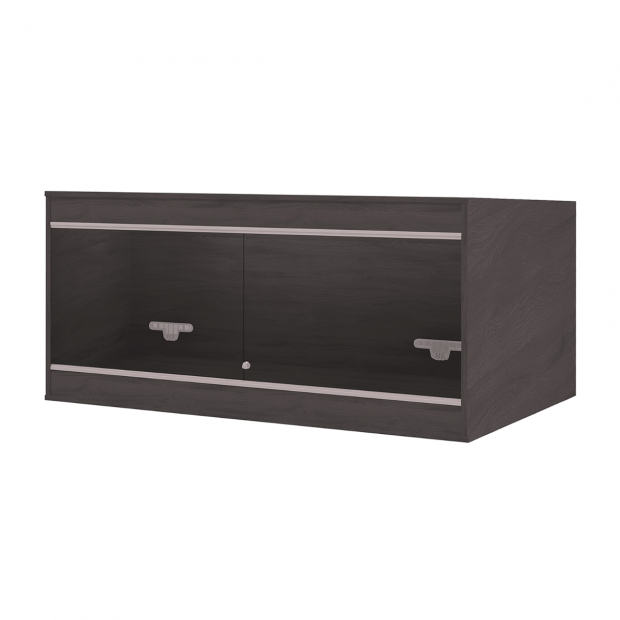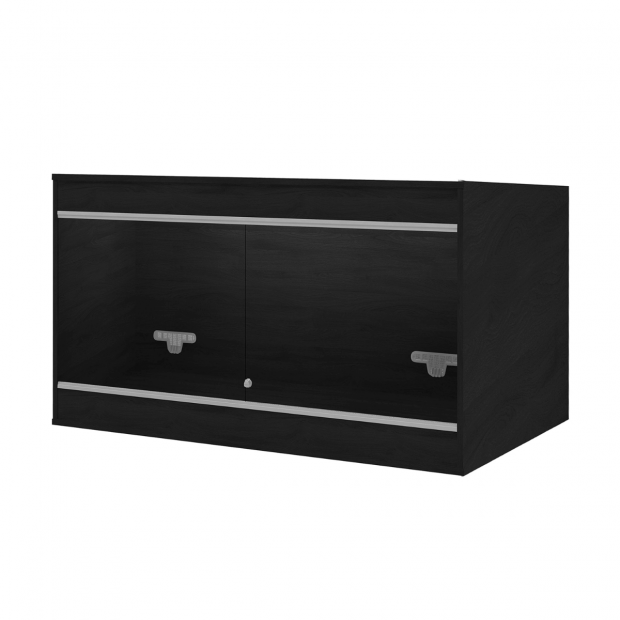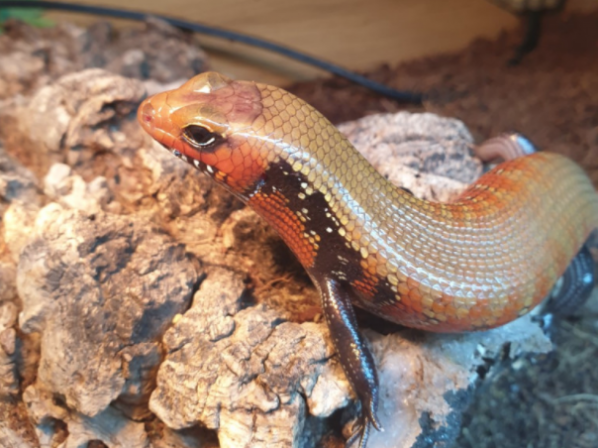-
Categories: Care sheetsLizards
Fire skink, Lepidothyris fernandi, care sheet
Fire skink, Lepidothyris fernandi, husbandry guide from the experts at Swell Reptiles, covering housing, heating, lighting and more.
- Fire skinks are a truly beautiful reptile with stunning colours
- A great choice for intermediate or experienced keepers
- Fairly easy care requirements but fiery personalities
Do Fire skinks make good pets?
Fire skinks are named for their striking red, yellow, orange and blue colourations which makes them a truly beautiful animal to behold. They are diurnal meaning they are most active during the daytime, which makes them a perfect candidate for a large display type enclosure. Any Fire skink will always have been captive bred in the UK, meaning you can rest assured that your new pet came from a reliable source with minimal impact on the environment.
This species is known for being rather feisty, so they are not generally a handling pet and although can be suitable for a well-prepared beginner, they are considered to be a slightly more intermediate species in the hobby. When more than one individual are kept together, particularly when they are not the same size, one individual is likely to be outcompeted by the other for food and other resources, so we do not recommend cohabitation for this species.
What size enclosure does a Fire skink need?
Fire skinks are terrestrial, quite active and are not the smallest of lizards, so they should be provided with plenty of floor space to roam around and explore. At Swell Reptiles, we recommend a minimum adult enclosure size of 120 x 60 x 60cm (4 x 2 x 2ft), although if you are able to go larger your skink will certainly appreciate this.
A good example of an adult Fire Skink enclosure would be the VivExotic Repti-Home (AAL) Vivarium Medium Oak, although being a wooden vivarium, additional measures will need to be taken to prevent humidity from seeping in at the joins and causing the boards to warp. This is most easily achieved using a reptile safe silicone lined along all of the inside joins of the vivarium.
A glass or PVC enclosure would be better in the consistent moisture required for a Fire skink, however, due to their larger enclosure requirements, this will usually be required to be a custom build.
What temperature should I keep my Fire skink at?
Fire skinks must be provided with a warm-cool thermogradient from one end of their enclosure to the other to allow them to regulate their body temperature. They do best with a basking temperature of 35°C (95°F) and a cool end temperature closer to 20°C (68°F).
As the enclosures they require are quite large, an overhead heating system is by far the best option, as under tank heating such as heat mats will not work well to warm the ambient temperature in such a large space. It is important to regulate all heating equipment with a compatible thermostat, so we recommend either using a heat bulb and dimming thermostat or a ceramic heater and pulse thermostat.
Do Fire skinks need to be provided with UVB?
Being diurnally active, Fire skinks are regularly exposed to sunlight in nature and as such require a UVI between 3-4. This is most regularly achieved using an Arcadia ProT5 Kit - 6% Forest placed 30-40cm (12-15”) above the skinks highest basking point. If your light fixture will need to be higher than this, but no higher than 60cm (24”), then an Arcadia ProT5 Kit - 12% Desert would be required.
How do I decorate a Fire skink’s vivarium?
Fire skinks love to burrow and have fairly high humidity requirements, therefore a loose, soil-based substrate is of particular importance for this species. This can be something simple such as plain coco soil, or a more sophisticated planting substrate such as Arcadia EarthMix if you would like to add live plants.
You should also consider adding more cover to your Fire skink enclosure, either by using traditional hiding caves, cork flats, rounds or half rounds and foliage in the form of live or artificial plants. These will help to reduce stress whilst also providing enrichment. You should also provide a good sized water dish to provide hydration whilst helping with humidity levels.
What do Fire skinks eat?
Fire skinks are insectivorous, so should be fed a varied diet of different livefoods such as crickets, locusts, cockroaches, mealworms, earthworms and snails. You can also offer the occasional pinkie mouse, but these are quite high in fat so should only be offered from time to time as a treat.
It is important to supplement all livefood offered to your Fire skink to ensure they are getting all of the required nutrients. This should follow a strict schedule, here we recommend using a calcium-rich multivitamin on every feed, such as Arcadia EarthPro-A, a calcium plus magnesium supplement on every fourth feed, such as Arcadia CalciumPro Mg and finally, a vitamin D3 supplement on every eighth feed such as Arcadia EarthPro RevitaliseD3.
How do I buy a Fire skink?
If you would like to purchase one of the UK captive bred skinks we have at Swell Reptiles, please pop down to our store to see us and bring some photos of your set-up, these will need to show an adequate sized enclosure, correct temperature and humidity parameters and adequate lighting.
We will ask to see your photos and ask a few quick questions to ensure our animals only go to the best homes possible. We reserve the right to refuse sale to anyone we feel is unprepared to adopt.
For more detailed husbandry information, please see our dedicated Fire skink care sheet. Or, you can check out some alternatives to the Fire skink, like the Pink tongue skink and the Western hognose snake.
| Common names | Fire skink |
| Scientific name | Lepidothyris fernandi |
| Country | West Africa |
| Captive-bred | Yes |
| Adult size | 38cm (15”) |
| Natural habitat | Forest, grassland and woodland habitats |
| Housing | 120 x 60 x 60cm (4 x 2 x 2ft) |
| Ideal temperature | 35°C (95°F) (warm end); 20°C (68°F) (cool end) |
| UVI | 3-4 |
| Ideal humidity | 60-70% |
| Diet | Insectivorous |
| Average lifespan | 15-20 years |
| Personality | Feisty |
| Ease of handling | Moderate |
| Cohabitable | No |
-
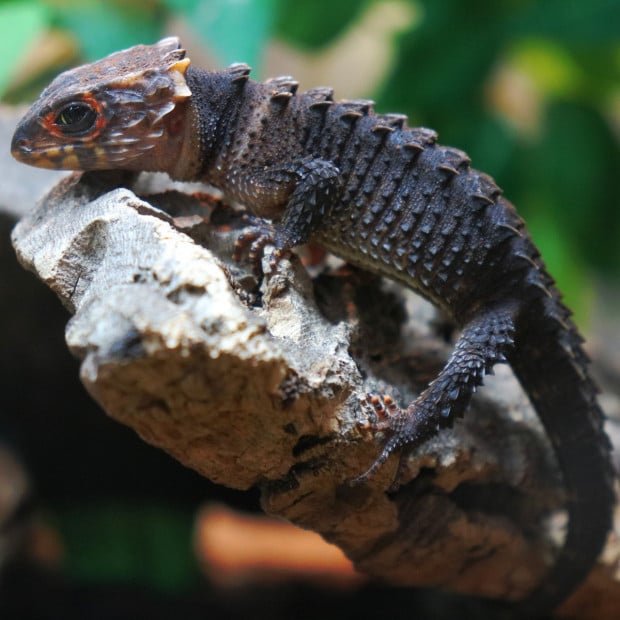 Red eye crocodile skink, Tribolonotus gracilisFrom £225.00Out of stock
Red eye crocodile skink, Tribolonotus gracilisFrom £225.00Out of stock -
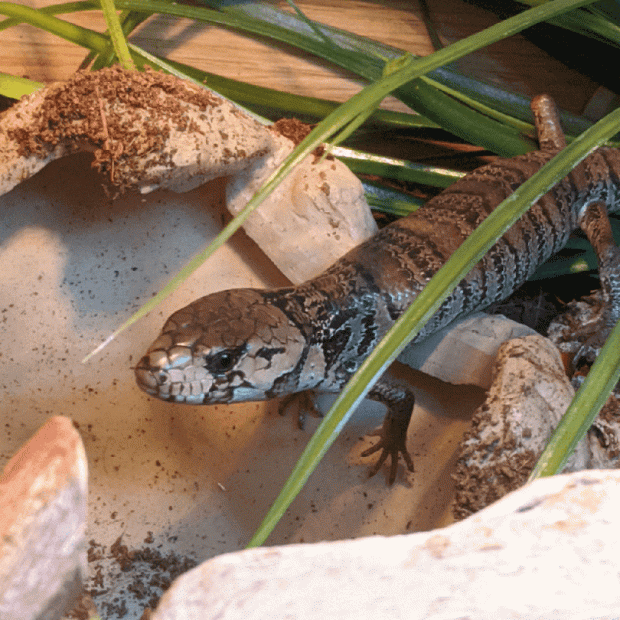 Pink tongue skink, Cyclodomorphus gerrardiiFrom £295.00Out of stock
Pink tongue skink, Cyclodomorphus gerrardiiFrom £295.00Out of stock -
 Emerald grass lizard, Takydromus smaragdinusFrom £85.00Out of stock
Emerald grass lizard, Takydromus smaragdinusFrom £85.00Out of stock -
 Casque head iguana, Laemanctus serratusFrom £145.00In stock
Casque head iguana, Laemanctus serratusFrom £145.00In stock





